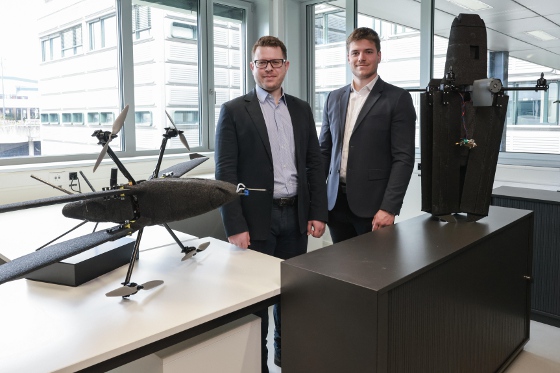 |
| May 09, 2023 | Volume 19 Issue 18 |
Designfax weekly eMagazine
Archives
Partners
Manufacturing Center
Product Spotlight
Modern Applications News
Metalworking Ideas For
Today's Job Shops
Tooling and Production
Strategies for large
metalworking plants
New drone design adapts to wind conditions and flight position in real time
A spin-off company called Elythor from EPFL, a University in Lausanne, Switzerland, has developed a new drone featuring a wing shape that can adapt to wind conditions and flight position in real time, reducing the drone's energy consumption. What's more, the position of the wings can change, allowing the drone to fly vertically or horizontally. These features make it a perfect candidate for applications in high-flying inspection.
Morpho inspection drone hovering. [Credit: Elythor/EPFL]
The Morpho inspection drone is part winged drone and part quadcopter. This hybrid unmanned aerial vehicle (UAV) can change shape according to the task at hand. Its adaptive wings extend the drone's flight time and give it greater maneuverability.
Combined with embedded sensors and cameras, these features let it fly just as well in enclosed spaces as in the open air, making it ideal for inspecting power plants and other infrastructure like high-voltage power lines, wind turbines, gas pipelines, and offshore oil platforms.
When sitting on its four legs, Morpho has a streamlined shape that resembles a tiny rocket, but that quickly changes once its rotors start whirring. The drone's vertical take-off capability means it can be deployed in confined spaces, fly to within just a few centimeters of a piece of equipment, and inspect the equipment without bumping into it.
Once the inspection is completed, Morpho can shift its motors and rotate into a horizontal, more aerodynamic position and swiftly fly off to the next inspection site. If the drone encounters strong or rapidly changing winds along the way, it will expand or contract its wings as necessary to maintain its trajectory. It can also glide under the right wind conditions. All these actions combined save time during inspections, and they also enable the drone to fly for longer periods.
VIDEO: New inspection drone uses wind to lengthen flight times. [Credit: Elythor/EPFL]
"We calculated that using Morpho can cut the time and cost of a drone inspection by an average of 35%," says Harry Vourtsis, Elythor co-founder and CEO. Once Morpho reaches the next inspection site, it can fold up its wings and return to a vertical position in order to fly right up to the equipment.
"Winged drones have the advantage of longer flight times, while quadcopters have better maneuverability," says Vourtsis. "We combined the two and added an adaptive wing system that reduces the drone's power requirement even further."
Most fixed-wing vertical take-off and landing (VTOL) drones represent a compromise, with wings that are small enough to reduce friction during vertical flight yet large enough to provide sufficient lift during horizontal flight. VTOL drones also have trouble taking off and landing in strong winds due to their large surface area perpendicular to the wind.

Harry Vourtsis, Elythor CEO and co-founder, and Nathan Müller, co-founder of the start-up. [Credit: EPFL/Alain Herzog]
Morpho's wing control system is the result of several years of research at EPFL's Laboratory of Intelligent Systems and has been described in a number of scientific articles. The system includes sensors linked to a software program for monitoring wind direction and speed. Nathan Müller, also an Elythor co-founder, explains, "The controller automatically selects whether to hold the wings in place or let them move freely with the wind, based on the drone's trajectory and effective speed, along with any changes in wind direction. The wings' surface area can also be adjusted either symmetrically or asymmetrically depending on wind direction."
The algorithms powering the control system seek not just to optimize the tradeoff between air friction and lift, but also to minimize power use. This entails taking advantage of wind currents to let the drone glide, adjusting the wings asymmetrically to regulate its yaw, or changing the rotation around its vertical axis. This provides greater stability in heavy winds.
Quantitative studies carried out at the EPFL lab show that Morpho delivers considerably better maneuverability and power efficiency. "Our design can reduce power use by up to 85% when the drone is fyling in the vertical position," says Müller. "It also significantly improves the drone's attitude and stability." These benefits mean Morpho can perform inspections under a broader range of weather conditions.
Because Elythor aims to provide customers with a turnkey solution, it's also developing software for compiling and analyzing the data collected by Morpho. "We want to revolutionize inspection platforms," says Vourtsis.
Elythor has raised a substantial amount of start-up funding and plans to get its drone ready for industrial production in the coming months, with a market launch slated for the end of this year.
Source: EPFL
Published May 2023
Rate this article
View our terms of use and privacy policy
